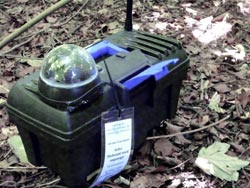Hands off – please! Friendly information signs reduce vandalism on scientific equipment

Dummy equipment with threatening message. <br>© Eleftherios Bitzilekis<br>
Consequently, damage to or theft of technical equipment represents a dramatic financial and scientific loss. Researchers from the Max Planck Institute for Ornithology in Seewiesen decided to find out whether the information content and tone of labels attached to the equipment could reduce the incidence of vandalism.
In total 60 equipment dummies were distributed in four public parks in Munich. The researchers found that a friendly, personal label reduced the interaction of people with the equipment in comparison with neutral or threatening labels.
From small transmitters used to study migration routes of butterflies to cameras in nest boxes recording breeding activities of great tits, state-of-the-art and expensive technical equipment is essential for today's ecological science. Usually, this equipment has to remain on site to allow for long-term observations or to minimize the impact of repeated installation.
For a team of researchers led by Markus Clarin and Holger Goerlitz from the Max Planck Institute for Ornithology in Seewiesen it is also important to get as close as possible to their study animals. They investigate the behaviour of bats, which spend their life in the dark, mostly during flight and in an acoustic environment unrecognizable to humans. Therefore the researchers have to rely on a range of special, expensive equipment to study the life of bats.
The idea for this study was thus born out of necessity: what and how much will happen to scientific equipment when it is left unattended in the field while automatically collecting data?
Does a written threat of being reported to the police or a friendly notice that the work is part of a student's thesis including a photo of a cute juvenile squirrel on the label of the equipment have the potential to prevent possible vandalism? Markus Clarin and colleagues distributed 60 equipment dummies in four public parks in Munich for a period of one week.
The dummies consisted of locked toolboxes with a fake dome camera with a flashing red LED light and a car antenna. The researchers attached a label to all of these dummies that either contained a personal, neutral, or a threatening message. “We have been frequently approached by interested park visitors”, says Markus Clarin, first author of the study. “With remorse we told all of them about our fictitious study on small mammals that have been equipped with transmitters and are being photographed by the camera on top of the boxes when passing close by.”
The good news first: most of the dummies were not touched at all, despite being highly visible and unsecured in the middle of the park. Dummies containing a friendly label were interfered with 40% less than those with a neutral or threatening label. The label type, however, did not affect the seriousness of the interference, such as moving, opening, damaging or stealing the dummy. “Apparently, the friendly label effectively reduced anybody’s interference with our equipment, regardless of whether they intended to damage or steal the equipment or just wanted to pick it up for closer inspection”, says Holger Goerlitz, head of the project.
The question remains whether this study is representative, as it has been conducted in one of the richest cities in Germany. To account for this the researchers first asked international colleagues about their experience with fieldwork equipment. Their survey showed that the equipment, such as animal traps or cameras, remained mostly untouched. In case of damage or theft, this resulted in dramatic financial and scientific consequences, and in extreme cases also in complete failure of an experiment. A label in a friendly tone could probably put things right. “Although our friendly labels were not able to influence what exactly was going to happen with the equipment, it nevertheless could minimize the number of incidences”, summarizes Holger Goerlitz.
“We would explicitly like to thank the local authorities, especially the police and the park management”, says Markus Clarin. They had been informed beforehand and remained cooperative, even when in one occasion a false bomb alert has caused some confusion: a visitor took one of the boxes to a beer garden and left it there with the red LED flashing. (SSP/HR)
Contact:
Dr. Holger Goerlitz
Max Planck Institute for Ornithology, Seewiesen
Phone: +49 8157 932-372
Email:hgoerlitz@orn.mpg.de
Media Contact
More Information:
http://www.mpg.de/7628561/vandalismAll latest news from the category: Life Sciences and Chemistry
Articles and reports from the Life Sciences and chemistry area deal with applied and basic research into modern biology, chemistry and human medicine.
Valuable information can be found on a range of life sciences fields including bacteriology, biochemistry, bionics, bioinformatics, biophysics, biotechnology, genetics, geobotany, human biology, marine biology, microbiology, molecular biology, cellular biology, zoology, bioinorganic chemistry, microchemistry and environmental chemistry.
Newest articles

An Endless Loop: How Some Bacteria Evolve Along With the Seasons
The longest natural metagenome time series ever collected, with microbes, reveals a startling evolutionary pattern on repeat. A Microbial “Groundhog Year” in Lake Mendota Like Bill Murray in the movie…

Witness Groundbreaking Research on Achilles Tendon Recovery
Achilles tendon injuries are common but challenging to monitor during recovery due to the limitations of current imaging techniques. Researchers, led by Associate Professor Zeng Nan from the International Graduate…

Why Prevention Is Better Than Cure—A Novel Approach to Infectious Disease Outbreaks
Researchers have come up with a new way to identify more infectious variants of viruses or bacteria that start spreading in humans – including those causing flu, COVID, whooping cough…



